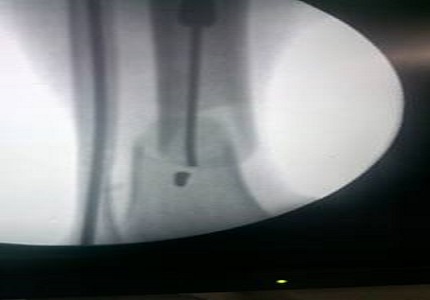A Study to evaluate the use of Steinmann pin as Poller screw for diametaphyseal fracture of distal tibia to avoid angular deformity
Abstract
Introduction: There are several important technical points that need to be observed when using an intramedullarynail to fix diametaphyseal fractures of distal tibia, mainly the angular deformity.
Objective: We aimed to describe a technique using 4.0-mm Steinmann pin which act like Poller screws, in conjunction with intramedullary nails to obtain alignment of diametaphyseal fractures of the distal tibia, andpresent our results.
Methods: 25 distal tibial diametaphyseal fractures who were treated with this technique were identified.
Results: There was no case of non-union or malunion at the last follow-up. all patients had post operative fracture angulation that was less than 5° degrees in the coronal and sagittalplanes.
Conclusion: Steinmann pin function essentially as a Poller screw for centralization of the nail and help to ensure reduction. Locking the nail in different directions, appropriater eduction can be maintained until the bone heals and there is no need for additional fixation material.
Downloads
References
2. Krettek C, Miclau T, Schandelmaier P et al. Themechanical effect of blocking screws (“Poller screws”) instabilizing tibia fractures with short proximal or distalfragments after insertion of small-diameter intramedullary nails. J Orthop Trauma 1999 ; 13 : 550-553.
3. Krettek C, Stephan C, Schandelmaier P et al. The use of“ Poller screws” as blocking screws in stabilizing tibial fractures treated with small diameter intramedullary nails.J Bone Joint Surg1999 ; 81-B : 963-968.
4. Ostrum RF, Maurer JP. Distal Third Femur Fractures Treated With Retro grade Femoral Nailing and Blocking Screws. J Orthop Traum2009 ; 23, 681-684.
5. Stedtfeld HW, Mittlmeier T, Landgraf P et al. The logic and clinical applications of blocking screws. J Bone Joint Surg2004 ; 86-A : 17-25. [PubMed]
6. Krettek C, Schandelmaier P, Tscherne H. Nonreamedinterlocking nailing of closed tibial fractures with severesoft tissue injury. ClinOrthop1995 ; 315 : 34-47. [PubMed]
7. Collinge AC, Wiss DA. Distal femur fractures, In :Rockwood and Green’s Fractures in adults. Seventh edition, vol. 2. Lippincott Williams & Wilkins. Philadelphiapress. 2010; 1729.
8. Marsh JL, Slongo TF, Agel J et al. Fracture and Dislocation Classification Compendium – 2007 : OrthopaedicTrauma Association Classification, Database andOutcomes Committee. J Orthop Trauma 2007 ; 21 : S1-133.
9. Freedman E, Johnson EE. Radiographic analysis of tibialfracture malalignment following intramedullary nailing.ClinOrthopRel Res 1995 ; 315 : 25-33.
10. Zelle BA, Bhandari M, Espiritu M et al. On behalf of theEvidence-Based Orthopaedic Trauma Working Group.Treatment of distal tibia fractures without articularinvolvement : a systematic review of 1125 fractures. J Orthop Trauma 2006 ; 20 : 76-79.
11. Ricci WM, Bellabarba C, Evanoff B et al. Retrogradeversus antegrade nailing of femoral shaft fractures. J OrthopTrauma 2001 ; 15 : 161-169.
12. Donald G, Seligson D. Treatment of tibial shaft fracturesby percutaneous Kuentschernailing : technical difficultiesand a review of 50 consecutive cases. ClinOrthop1983 ;178 : 64-73.
13. Krettek C, Rudolf J, Schandelmaier P et al. Unreamedintramedullary nailing of femoral shaft fractures : operativetechnique and early clinical experience with the standardlocking option. Injury 1996 ; 27 : 233-254.
14. Ricci WM, O’Boyle M, Borelli J, BellabarbaC,Sanders R. Fractures of the Proximal Third of the Tibial Shaft Treated With Intramedullary Nails and BlockingScrews. J Orthop Trauma 2001 ; 15 : 264-270.
15. Shahulhameed A, Roberts CS, Ojike NI. Technique forprecise placement of poller screws with intramedullarynailing of metaphyseal fractures of the femur and the tibia.Injury2011 ; 42 : 136-139. [PubMed]
16. Işik M, Subaşi M, Karsli B, Sariçiçek V, KarsliG.Intramedullary nailing and angulation prevention in distalmetaphyseal tibial fractures. Orthopedics2012 ; 35 :e1765-8. [PubMed]



 OAI - Open Archives Initiative
OAI - Open Archives Initiative


















 Therapoid
Therapoid

